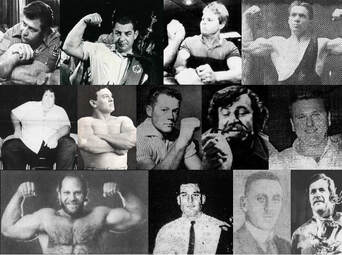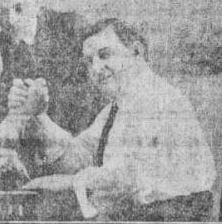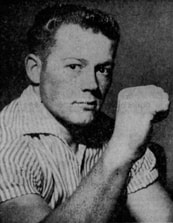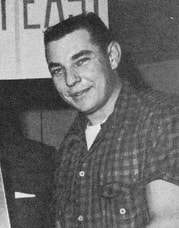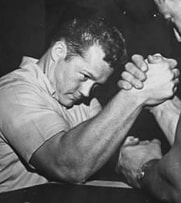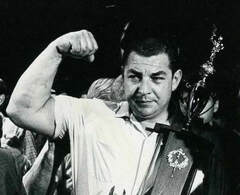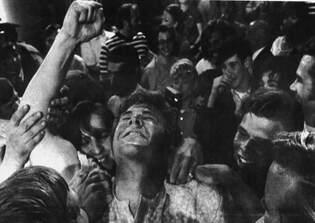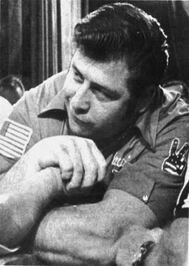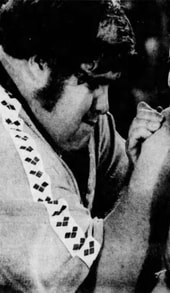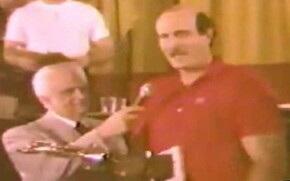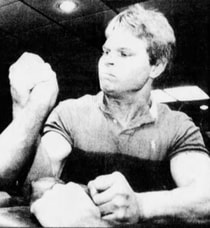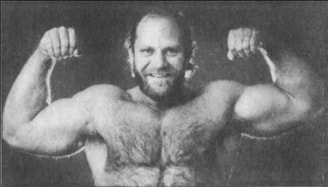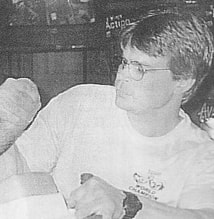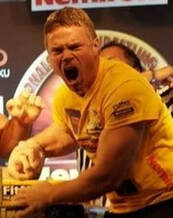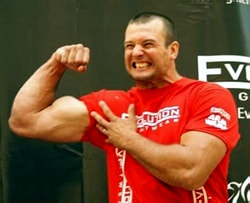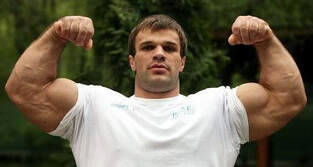Best Pullers by Year
A look at the pullers who were likely most worthy of the title of “Best Puller of the Year” throughout organized armwrestling history, based on an analysis of accomplishments within each calendar year. Note that only the right arm is considered, and "best" is based on performance in an open weight class.
1900 – Ovila Chapleau
At the turn of the 20th century, armwrestling matches first began receiving media attention in Montreal, Canada, and the puller who established himself as the man to beat was Ovila Chapleau. Through the late 1800s and into 1901, he was reputed to be unbeaten.
1901 – Hector Décarie
Strongman Hector Décarie wasn’t a puller, but in 1901 he decided to try his shot against Chapleau. He proceeded to do what many thought wasn’t possible: he defeated him. This win immediately put Hector at the top of the armwrestling food chain.
1902 and 1903 – Ovila Chapleau
Hector Décarie’s focus was on feats of strength and wasn’t particularly interested in pulling. He became inactive following his win over Chapleau, and the latter was once again the top puller. He is believed to have suffered no losses in these two years.
1904 to 1906 – Arthur Dandurand
In 1904, practicing strongman Arthur Dandurand pulled Chapleau in a big money match and defeated him in three straight pulls, making him the man to beat among active competitors. In 1905, he solidified his position by winning the first ever tournament to crown an Armwrestling Champion of Canada. He continued to win all his matches through 1906.
1907 and 1908 – Ovila Chapleau
By 1907, Ovila Chapleau was back on top. He convincingly defeated Jean-Baptiste Dubé, who had defeated Arthur Dandurand a few months prior.
1909 – Jean-Baptiste Dubé
In 1909, Jean-Baptiste and Ovila had rematch, with Dubé winning this time. If someone wanted the Canadian armwrestling crown, they would now have to beat him.
1910 to 1920 – Théophile Massé
In 1910, a young man by the name of Théophile Massé defeated Dubé and began an 11-year reign as Canada’s top puller. He is believed to have faced a handful of challengers each year, remaining undefeated during this entire span of time. All of these matches were for money. One person he really wanted to pull was Arthur Dandurand, because they had never faced each other, and many thought Dandurand would win. Massé finally got his chance in 1915 and proceeded to soundly defeat him.
1921 – Hector Décarie
Another puller that Théophile wanted to face was Hector Décarie. Hector had never lost a match, but continued to reject Massé’s challenges, because he was a professional strongman and he didn’t want to take away from his training to have an armwrestling match. There had to be enough money on the line to make it worth his while. After lots of negotiations, the match was finally set, with $500 bet on each side (the equivalent of approximately $7,500 in today’s dollars). The conditions were favourable to Décarie’s style of pulling, but nonetheless Massé accepted the match. Théophile would pay the price for giving in to all of Hector’s demands: for the first time in 11 years, he was defeated.
1922 to 1930 – Théophile Massé
Hector was perfectly content to retire from pulling following his defeat of Mr. Massé. By default Théophile Massé was back on top once again as he continued to actively pull, accepting challenges from any and everyone through the 1920s. He is believed to have never lost again until he retired from the sport.
1931 to 1956 – Ian “Mac” Batchelor
Around the time Mr. Massé retired and the popularity of the sport was winding down in Canada, a young barkeeper and strongman in California by the name of Mac Batchelor was building a reputation of being unbeatable at the arm game. Over the course of 25 years, he agreed to pull anyone who came to his bar to try to beat him. He faced thousands of men, and never lost a single match. Whether standing or seated, left arm or right, he defeated all opponents, in any style. As there were no organized tournaments in these years, only one of these matches was conducted in an “official” setting. It occurred in 1946 in Los Angeles and it was for the title of “World’s Wristwrestling Champion”. Mac won the 2-out-of-3 match by a score of 2-0 over challenger Earl Audet.
1957 – Bob Knight
In 1956 Mac Batchelor officially announced his retirement from armwrestling and that he would no longer be accepting challenges. So, in 1957 Arizona’s Bob Knight might have been the best. Organized tournaments started being held in Arizona in 1955 in conjunction with weightlifting contests, and Bob was undefeated over the course of several years.
Between the late 1950s and late 1960s, the annual Petaluma wristwrestling tournament (first called the World’s Wristwrestling Championship in 1962) was THE tournament to win if you wanted to be considered the best puller. During this period, very few other events were held, and none came close to matching the level of talent that was in Petaluma each year. For this reason, the world’s best puller of each year was by default the champion of the unlimited division. Between 1958 and 1968, the winner in Petaluma either defeated the reigning champion, or the champion became inactive once he won his world title.
The following Californians occupied the top spot during these years:
Between the late 1950s and late 1960s, the annual Petaluma wristwrestling tournament (first called the World’s Wristwrestling Championship in 1962) was THE tournament to win if you wanted to be considered the best puller. During this period, very few other events were held, and none came close to matching the level of talent that was in Petaluma each year. For this reason, the world’s best puller of each year was by default the champion of the unlimited division. Between 1958 and 1968, the winner in Petaluma either defeated the reigning champion, or the champion became inactive once he won his world title.
The following Californians occupied the top spot during these years:
1958 to 1960 – Earl Hagerman
1961 – Duane “Tiny” Benedix
1962 – Earl Hagerman
1963 – Tiny Benedix
1964 – Joe Schuler
1965 – Arnie Klein
1966 – Mike Rowe
1967 – Larry Finley
1968 and 1969 – Tiny Benedix
The late 1960s saw the emergence of the International Federation of Arm Wrestlers, which held its own world championship. Connecticut’s Maurice Baker quickly became the face of the organization when he won the world championship in 1968, 1969, and 1970. But given the Petaluma tournament attracted so many more pullers, it is believed that Petaluma’s champ in 1968 and 1969, Tiny Benedix, has a more legitimate claim to being the best puller in these two years.
1970 and 1971 – Jim Dolcini
Tiny Benedix did not return to Petaluma for the 1970 contest, leaving the door open for a new top dog. 1968 middleweight champion Jim Dolcini had put on considerable weight and emerged champion of the tournament. It is difficult to choose who is most deserving of the title of “best of 1970” between Dolcini and Baker, however because Baker is known to have suffered a loss that year, and Dolcini is not, the nod goes to Jim. In 1971, the world got to see the showdown between the two men when Mo travelled to Petaluma for the World’s Wristwrestling Championship. While Baker got the jump on Dolcini, Jim was able to put on the breaks just prior to being pinned bringing Mo’s arm back up and over for the win and the title.
1972 – Maurice Baker
Baker was very bothered by his loss to Dolcini in ’71, and so he made a vow to train hard and return in ’72 to beat him. Once again, the two met in the finals, but this time Mo won convincingly. Jim said that he had never felt anything like it.
1973 – Bill Harrison
In 1973, Baker returned to Petaluma, but this time to everyone’s surprise he lost to a lesser-known Californian named Bill Harrison. With this win and the World’s Wristwrestling title, Bill is deserving of being recognized as the top puller of the year.
1974 and 1975 – Jim Dolcini
Having sat out the Petaluma event in 1973 because he was recovering from an injury, Jim returned in 1974 and won both the WWC Nationals and Worlds. In doing so, he made it clear that HE was the best around. He backed this up by winning his fourth unlimited division world wristwrestling title in 1975.
1976 and 1977 – Virgil Arciero
After repeated attempts, California’s Virgil Arciero finally defeated Jim Dolcini in a tournament in 1976 and went on to remain the king of the heavyweights for two years by winning every event he entered.
1978 to 1981 – Cleve Dean
Georgia’s Cleve Dean burst onto the scene in 1978 by winning the heavyweight titles at both the WWC Nationals and Worlds. Virgil was active in 1978, but did not attend these two events. When the two finally met up in a big-money supermatch in November of that year, it became clear that there was a new king of the mountain. Cleve would go onto to be the world’s most dominant super heavyweight for several years, and while he did not win every single match he pulled, he won considerably more than any of his competitors.
1982 – Virgil Arciero
In January 1982 AWI hosted a world pro super heavyweight tournament that attracted most of the top pullers of the time. Virgil Arciero won the class and Cleve took fourth place. It was Dean’s worst showing ever. The Georgia hog farmer then decided to take a break from major competition for the rest of the year to train seriously. Virgil Arciero therefore receives the nod for being the best of ’82.
1983 to 1985 – Cleve Dean
After a year of dedicated training, Cleve returned to the AWI tournament in January 1983 in the best shape of his life. He proceeded to defeat all his opponents in decisive fashion. Dean was back on top, and would remain there for the next three years.
1986 – Scott Norton
When it was announced in 1985 that the biggest tournament of all time would be held in the summer of 1986 and that footage of the event would be included in a Sylvester Stallone movie about an armwrestler, lots of pullers became very motivated. Some, like Scott Norton, even began training full time leading up to the Over the Top World Championships to show up as ready as possible. His hard work paid off: he defeated Cleve Dean to win the pro super-heavyweight class. Having several wins over John Brzenk in previous years and no losses, he is recognized as the best of ’86.
1987 and 1988 – John Brzenk
In 1987, both Scott Norton and Cleve Dean had dropped out of the sport, leaving the door open for someone to take over as the world’s best. John Brzenk had won the heavyweight Truckers class at the Over the Top World Championships, and in 1987 he finished at the top of the heavyweight class at more major tournaments than anyone else. He had become the man to beat, and would remain so for a couple of years.
1989 – Richard Lupkes
In 1989, a behemoth from Minnesota dominated the sport. Richard Lupkes defeated everyone in his path that year, including John, and made it look easy.
1990 to 1993 – John Brzenk
John would avenge his loss to Richard at the 1990 Yukon Jack Finals. Over the next three years he won virtually every event he entered, and was always the favourite.
1994 to 1996 – Gary Goodridge
1994 saw Canada’s Gary Goodridge defeat John Brzenk twice at the Yukon Jack World Championships. And while Cleve Dean very narrowly defeated Gary in the finals of the tournament, the sum of each competitor’s accomplishments over the entirety of the year lead to the belief that Gary is most deserving of being recognized as the best of ’94. In 1995 and 1996, Gary just continued to distance himself from the rest of the pack – he was undoubtedly the best of these years.
1997 to 2003 – John Brzenk
With Gary retiring from the sport to focus on a career in professional mixed martial arts, John Brzenk was once again the guy to beat if you wanted to be considered the best. He was virtually unbeaten between 1997 and 2003, a period that saw him travel the world to attend the biggest and best tournaments.
2004 – Alexey Voevoda
Russian phenom Alexey Voevoda quickly became Europe’s top puller in the early 2000s. When he attended the WAF World Championships in Ottawa in December 2003, most expected him to win. However, Travis Bagent shocked the world when he sent Alexey home with the silver medal. Like Baker and Dean had done previously, Voevoda used the loss as motivation and to train hard the following year to become as strong as possible. When Alexey made it to the Nemiroff World Cup in November 2004, he was ready, and he finished atop a field that included both Travis and John. He made it clear that HE was now the best.
2005 – Travis Bagent
In 2005, Alexey stepped back from the sport to focus on becoming a member of the Russian Olympic bobsled team. He competed in a couple of left-hand supermatches, but isn’t believed to have competed with his right. So who was the best active right-hand puller of 2005? It was likely Travis Bagent. That year he won the Arnold Classic, the Absolute division of the Nemiroff World Cup (ahead of John Brzenk and Andrey Pushkar), the PAC Mohegan Sun Worlds, and had a supermatch victory over Devon Larratt. While he lost 3-1 to Jerry Cadorette in a supermatch near the end of the year, all things considered, he is deserving of being recognized as the best of 2005.
2006 and 2007 – John Brzenk
After competing in the 198-lb class for much of 2005, John Brzenk decided to pack on some muscle in early 2006, leading to tremendous success at the armwrestling table. He won the Arnolds, the Mike Gould Classic, and the Ultimate Armwrestling Las Vegas tournaments in rapid succession, defeating many of the world’s top pullers – even letting them get into their strongest positions! The following couple of years would see him win the Absolute division of the Nemiroff World Cup, cementing his status as the best of the period.
2008 to 2010 – Devon Larratt
In September 2008, Canada’s Devon Larratt defeated John Brzenk 6-0 in an Arm Wars supermatch, establishing himself as the new man to beat in order to be considered the best. Over the following two years he would win every event in which he competed, registering victories over pullers such as David Randall, Tim Bresnan, Richard Lupkes, Don Underwood, Mike Gould, Earl Wilson, Sylvain Perron, and Travis Bagent.
2011 to 2013 – Denis Cyplenkov
While Devon and Russian Denis Cyplenkov didn’t meet in 2011, their respective accomplishments that year lead to the belief that Denis was slightly more deserving of the title of Best of 2011. That year he won the Arnold Classic, and both the super heavyweight class and the Absolute division of the Nemiroff World Cup. His performances at Europe’s top professional events (Nemiroff and the A1 Russian Open) over the following couple of years, lead to the belief that his right arm was the very best of the time.
2014 to 2017 – Andrey Pushkar
Ukraine’s Andrey Pushkar had been among the world’s very best pullers for ten years before he finally reached the top spot in 2014 upon his defeat of Denis Cyplenkov in the finals of the Absolute division of the A1 Russian Open. The next few years would see him win another Absolute division win at the A1 Russian Open as well as at the Zloty Tur, plus register supermatch victories over Richard Lupkes, Dmitry Trubin, and Michael Todd.
2018 to 2020 – Levan Saginashvili
With Andrey’s tragic passing in a car accident in November 2018, Georgian powerhouse Levan Saginashvili quickly positioned himself as the world’s best in 2018. That year he won the super heavyweight class at the WAF World Championships and enjoyed a 6-0 supermatch victory over Dmitry Trubin. He then had a perfect record in 2019, registering supermatch victories over Tim Bresnan, Kydyrgaly Ongarbaev, and Vitaly Laletin, garnering $50,000 for his success. With the sport being almost completely shut down in 2020 due to the COVID-19 pandemic, Levan is also given the nod for that year.
Researched and Written by Eric Roussin
Originally Published in January 2021
Researched and Written by Eric Roussin
Originally Published in January 2021
